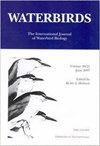气候变化对古巴美洲火烈鸟(Phoenicopterus ruber)分布的潜在影响
IF 0.6
4区 生物学
Q3 ORNITHOLOGY
引用次数: 0
摘要
摘要依赖湿地的鸟类被认为受到气候变化负面影响的风险特别高。生物气候模型被广泛用于评估物种对气候变化的潜在反应。我们预测了美洲火烈鸟(Phoenicopterus ruber)现在和未来的分布;利用生态位模型结合Maxent软件中的气候数据,研究了古巴的一种常住物种——凤凰科(Phoenicopteridae)。我们结合三种全球环流模型,预测了2050年和2070年两种排放情景下古巴的四种潜在未来分布。对美洲火烈鸟模型分布贡献最大的生物气候变量是平均日温差[月平均(最高温度-最低温度)]、温度季节性和最湿季降水。我们的研究结果预测,在2070年最悲观的情况下,在未来气候变化的情况下,美国火烈鸟目前的分布将减少38%。在同样的情况下,美洲火烈鸟的潜在栖息地将有51%被排除在古巴国家保护区系统之外。物种分布模型可以为整个古巴的美洲火烈鸟的当前和未来管理提供信息,我们的研究结果表明,在不断变化的气候下,需要强有力的保护策略来保护美洲火烈鸟种群。本文章由计算机程序翻译,如有差异,请以英文原文为准。
Potential Effects of Climate Change on the Distribution of American Flamingo (Phoenicopterus ruber) in Cuba
Abstract. Wetland-dependent birds are considered to be at particularly high risk for negative climate change effects. Bioclimatic models are widely used tools for assessing potential responses of species to climate change. We predicted current and future distributions of American Flamingo (Phoenicopterus ruber; Family Phoenicopteridae), a resident species in Cuba, using ecological niche models in combination with climate data in Maxent software. We predicted four potential future distributions in Cuba under two emissions scenarios in both 2050 and 2070, combining three Global Circulation Models. Bioclimatic variables that contributed the most to modelled distributions of American Flamingo were mean diurnal temperature range [mean of monthly (max temp - min temp)], temperature seasonality, and precipitation of wettest quarter. Our results predict that the current distribution of American Flamingo will be reduced by 38% in a changing future climate under the most pessimistic scenario of 2070. The potential suitable habitat of American Flamingo under this same scenario would be 51% excluded from the National System of Protected Areas of Cuba. Species distribution modeling can inform the current and future management of the American Flamingo throughout Cuba, and our findings suggest a strong conservation strategy is needed to conserve American Flamingo populations under a changing climate.
求助全文
通过发布文献求助,成功后即可免费获取论文全文。
去求助
来源期刊

Waterbirds
生物-鸟类学
CiteScore
1.30
自引率
0.00%
发文量
0
审稿时长
6-12 weeks
期刊介绍:
Waterbirds is an international scientific journal of the Waterbird Society. The journal is published four times a year (March, June, September and December) and specializes in the biology, abundance, ecology, management and conservation of all waterbird species living in marine, estuarine and freshwater habitats. Waterbirds welcomes submission of scientific articles and notes containing the results of original studies worldwide, unsolicited critical commentary and reviews of appropriate topics.
 求助内容:
求助内容: 应助结果提醒方式:
应助结果提醒方式:


